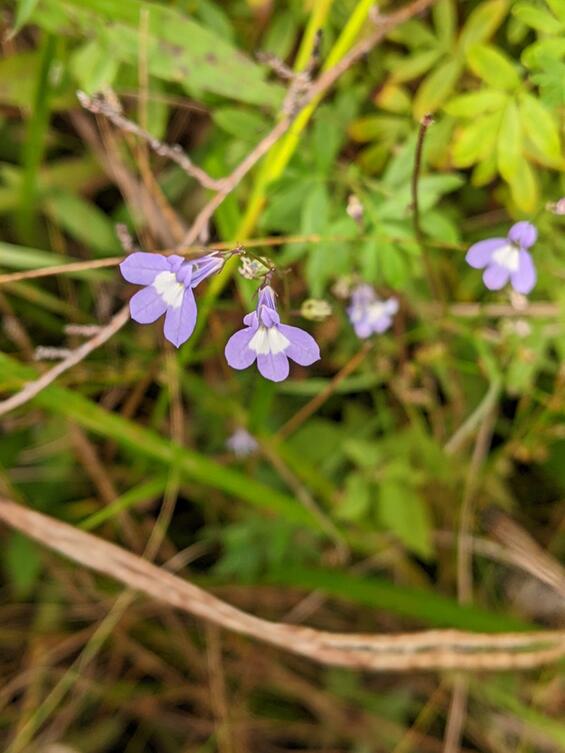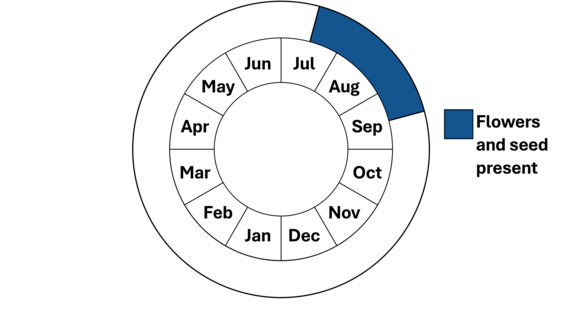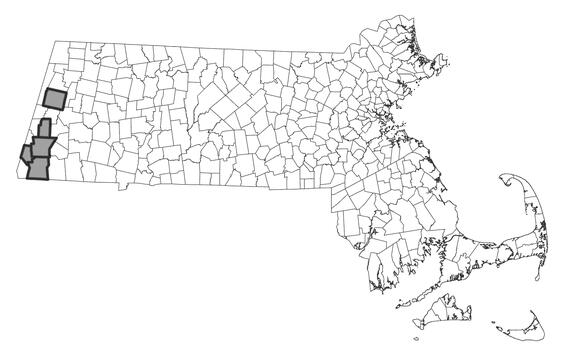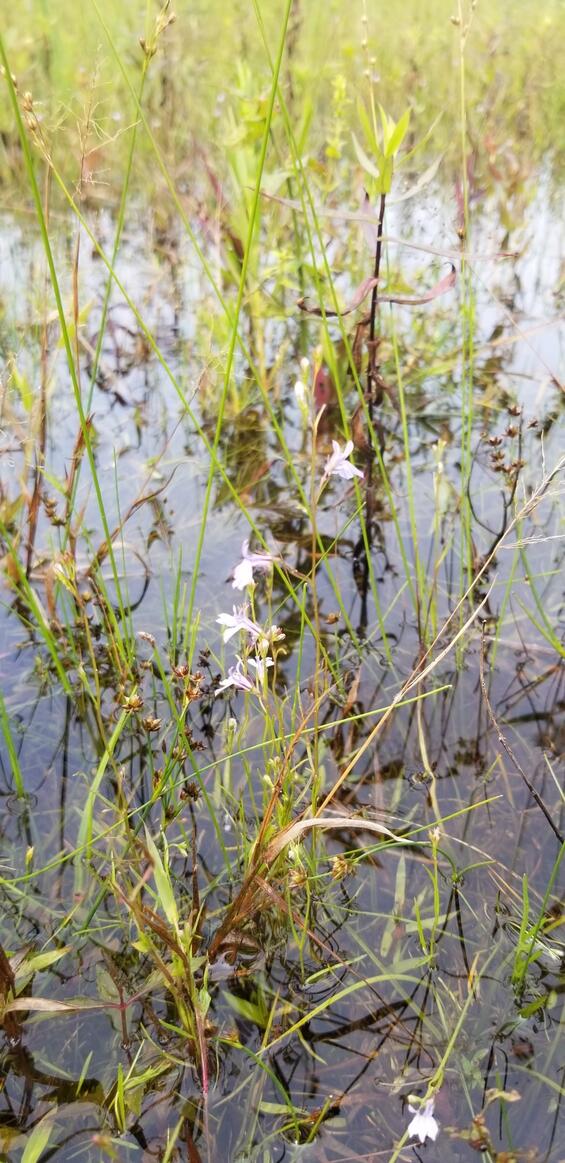- Scientific name: lobelia kalmii L.
Species of Greatest Conservation Need (MA State Wildlife Action Plan)
Description

Close up of flowers. Photo credit: Robert Wernerehl
Brook-lobelia, Lobelia kalmii, is a delicate, perennial herbaceous species in the bluebell family (Campanulaceae). The species epithet, kalmii, is after the person who discovered it, Pehr Kalm, a Swedish botanist and a student and friend of Carl Linnaeus. Brook-lobelia typically has a single stem, that is occasionally branched and grows up to 40 cm (15 in) high. It produces terminal racemes of pale blue flowers with a distinct white center. The flowers are attached to pedicels 6 to 25 mm (0.25-1 in) long. The alternate flowers are often all on one side (secund) and are 7-13 mm (0.25-0.5 in) long. The flowers are bilaterally symmetrical with 2 fused petals forming an upper lip and 3 fused petals forming the lower lip. Its basal leaves are spatulate, 1-3 cm (0.4-1.2 in) long. The alternate cauline (stem) leaves are linear, 1-5 cm (0.4-2 in) long and no wider than 5 mm (0.2 in) The fruit is an oval capsule 3-6 mm (0.125-0.25 in).
Life cycle and behavior

Brook-lobelia is a perennial species that blooms from mid-July to mid-September. It is insect pollinated, possibly by small butterflies or bees. Each capsule splits open releasing numerous tiny seeds, that may be wind-blown, or if they fall near the parent plant, water borne to a new location.
Population status
Brook-lobelia is recently listed as a species of greatest conservation need and is maintained on the plant watch list. There are currently 8 occurrences in the state verified since 1999 found in Berkshire County. Three historical occurrences which have specific locational information were previously observed in Berkshire County.
Distribution and abundance
Brook-lobelia is known across Canada and extends south to West Virginia and Washington state. It is considered critically imperiled, imperiled or vulnerable in much of its southern range. In New England, it is considered imperiled in Massachusetts and New Hampshire, vulnerable in Connecticut, and secure in Vermont. It has not been ranked in Maine and is not known to occur in Rhode Island.

Distribution in Massachusetts. 1999-2024. Based on records in the Natural Heritage Database.
Habitat

Brook lobelia habitat. Photo credit: Karro Frost
Brook-lobelia may be found in damp calcareous soil, in meadows, bogs and fens in Massachusetts. It usually is growing in open sunny areas, sometimes in seasonal shallow water.
Healthy habitats are vital for supporting native wildlife and plants. Explore habitats and learn about conservation and restoration in Massachusetts.
Threats
The ecological needs of this species are not well known. It is likely that threats include changes in hydrology, including changes in rainfall as a result of climate change, which may lead to extremes both in excessive rainfall and in prolonged droughts (Staudinger et al. 2024). Another threat that has been mentioned by observers is the presence of the invasive plant, Phragmites australis, which can shade this species and prevent it from growing. It is near the southern edge of its range in Massachusetts so may be impacted by a warming climate as well.
Conservation
Brook-lobelia is uncommon in Massachusetts and has only a few known occurrences. It needs additional surveys, both of the known populations and of ones in potential habitats. It is best surveyed when in flower from mid-July to mid-September.
The ecological needs of brook-lobelia are not well known. It is thought that invasive plant species are a major threat to it and should be controlled.
As this plant is under-surveyed, more standard information is needed such as lists of associated species, comments on habitat quality and threats, and assessments of soil conditions and phenology. Research is needed to determine whether this plant can be grown in a nursery or garden setting for purposes of reintroductions. If habitat degradation accelerates losses of current populations, this strategy could prove useful to long-term conservation of this species.
References
Fernald, M. L. 1950. Gray’s Manual of Botany, Eighth (Centennial) Edition—Illustrated. American Book Company, New York.
Gleason, Henry A., and Arthur Cronquist. Manual of Vascular Plants of Northeastern United States and Adjacent Canada, Second Edition. Bronx, NY: The New York Botanical Garden, 1991.
Haines, A. 2011. Flora Novae Angliae – a Manual for the Identification of Native and Naturalized Higher Vascular Plants of New England. New England Wildflower Society, Yale Univ. Press, New Haven, CT.
Illinois Wildflowers website: https://www.illinoiswildflowers.info/wetland/plants/kalm_lobelia.html Accessed 4/1/2025.
NatureServe. 2025. NatureServe Network Biodiversity Location Data accessed through NatureServe Explorer [web application]. NatureServe, Arlington, Virginia. Available https://explorer.natureserve.org/. Accessed: 4/1/2025.
POWO (2025). Plants of the World Online. Facilitated by the Royal Botanic Gardens, Kew. Published on the Internet; https://powo.science.kew.org/ Accessed: 4/1/2025.
Staudinger, M.D., A.V. Karmalkar, K. Terwilliger, K. Burgio, A. Lubeck, H. Higgins, T. Rice, T.L. Morelli, A. D'Amato. 2024. A regional synthesis of climate data to inform the 2025 State Wildlife Action Plans in the Northeast U.S. DOI Northeast Climate Adaptation Science Center Cooperator Report. 406 p. https://doi.org/10.21429/t352-9q86
Contact
| Date published: | April 30, 2025 |
|---|